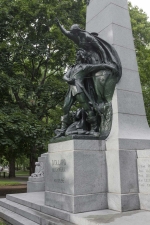Alfred Laliberté
Monument à Dollard des Ormeaux
1920
Presentation of the artwork
Commemorating an important – but controversial – event in Canadian history, Alfred Laliberté’s Monument à Dollard des Ormeaux illustrates the heroism, courage, and tenacity of the man who personified the nationalist sentiment and the desire to write the history of Québec that ruled at the time.The reading of the bronze sculptural grouping is guided by the imposing pedestal produced by the architect Alphonse Venne. In an original shape for the time, it created order for the different elements of the composition. To the left and right, bas-reliefs relate the events of the battle; in the centre, the statuary ensemble can be viewed from the front only; above, the allegorical figure of France towering protectively over the heroic figure is surpassed only by the triumphant face of New France at the top of the column.
The work combines the realism of the main figure with a profusion of symbols (lily, maple leaf), adding an important semantic aspect to the event commemorated. This work, one of the most notable of Laliberté’s career, is influenced by the work of Auguste Rodin and the style in fashion in the early twentieth century at the Salon des artistes français in Paris.
Associated events
The monument pays tribute to Sieur Adam Daulac des Ormeaux, known as Dollard des Ormeaux (1635–60), a heroic figure in French Canadian history, notably due to the writings of Lionel Groulx.
Commandant of the fort at Ville-Marie, Dollard des Ormeaux undertook an expedition to the Outaouais in 1660 to defend the colony from future Iroquois attacks. When the mission turned to confrontation, he and his companions took refuge in an abandoned fort. The Battle of Long-Sault lasted a number of days and convinced the Iroquois to review their plan of attack for Ville-Marie.
Alfred Laliberté
Born in 1878 in Sainte-Élizabeth-de-Warwick, in the Bois-Francs region, Alfred Laliberté received training at the Conseil des arts et manufactures in Montréal; when he was 23, he went to study at the prestigious École des beaux-arts de Paris. He returned to Canada in 1907 and became a professor at the École des beaux-arts de Montréal in 1922.
A prolific artist, Laliberté produced more than 920 sculptures. Some were portrayals of important historical figures, including statues of Father Brébeuf and Father Marquette in Québec City, whereas others evoked rural traditions and legends, such as the series of bronzes commissioned by the Québec government in 1928. Laliberté was long regarded as Québec’s “national sculptor”.
A prolific artist, Laliberté produced more than 920 sculptures. Some were portrayals of important historical figures, including statues of Father Brébeuf and Father Marquette in Québec City, whereas others evoked rural traditions and legends, such as the series of bronzes commissioned by the Québec government in 1928. Laliberté was long regarded as Québec’s “national sculptor”.
Awards and honours
- doctorat Honoris Causa, Université de Montréal. , 1940






